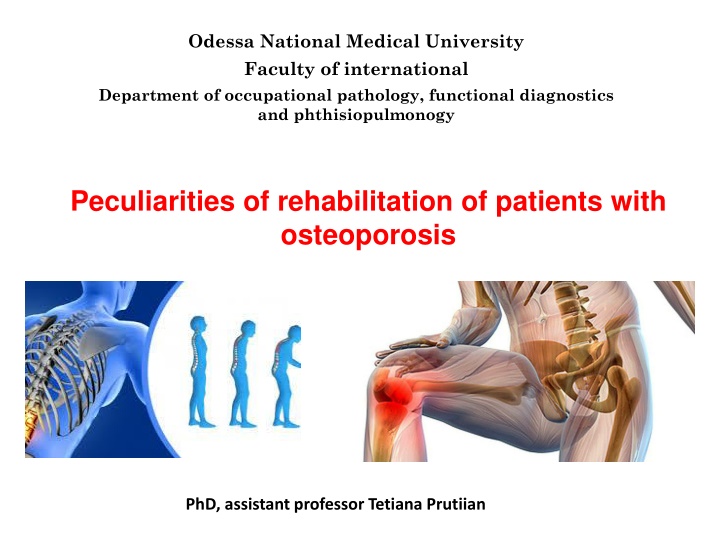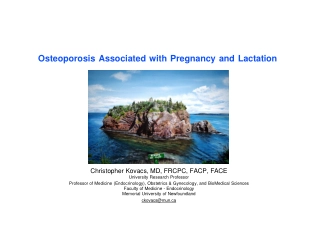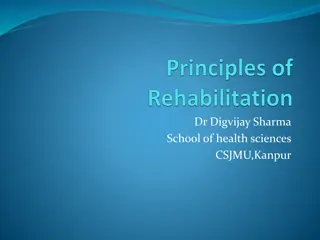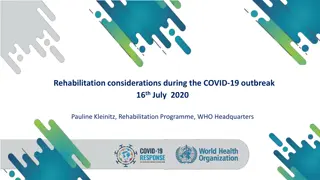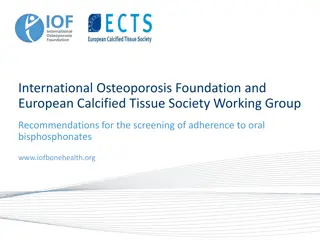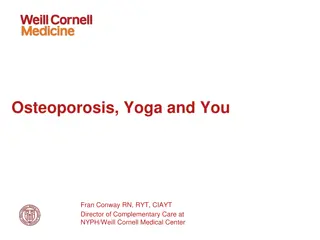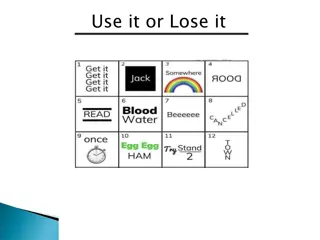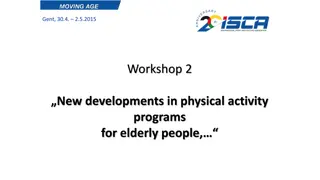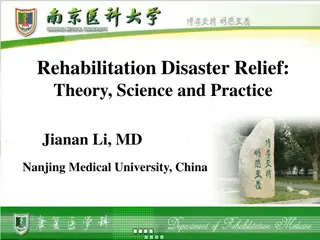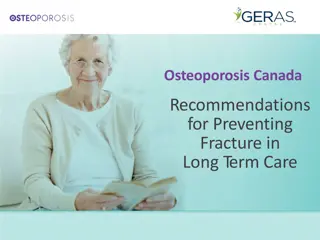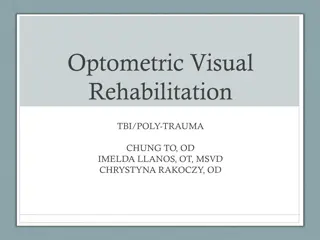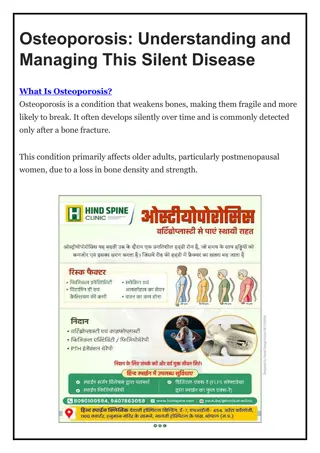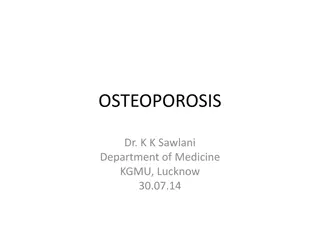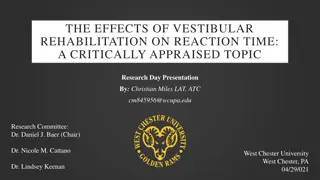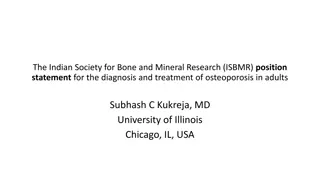Rehabilitation Measures for Osteoporosis Patients: Importance of Physical Activity and Physiotherapy
Rehabilitating patients with osteoporosis involves physical activity, muscle training, and physiotherapy to improve quality of life, bone health, and reduce fall risks. The integrated use of physiotherapy methods enhances bone tissue restoration.
Download Presentation

Please find below an Image/Link to download the presentation.
The content on the website is provided AS IS for your information and personal use only. It may not be sold, licensed, or shared on other websites without obtaining consent from the author.If you encounter any issues during the download, it is possible that the publisher has removed the file from their server.
You are allowed to download the files provided on this website for personal or commercial use, subject to the condition that they are used lawfully. All files are the property of their respective owners.
The content on the website is provided AS IS for your information and personal use only. It may not be sold, licensed, or shared on other websites without obtaining consent from the author.
E N D
Presentation Transcript
Odessa National Medical University Faculty of international Department of occupational pathology, functional diagnostics and phthisiopulmonogy Peculiarities of rehabilitation of patients with osteoporosis PhD, assistant professor Tetiana Prutiian
The main goal of rehabilitation measures is to improve the patient's quality of life and functionality, restore or maintain their ability to care for themselves and remain socially active. Physical activity in the form of dosed physical activity and muscle training is of great importance for patients with impaired structural and functional bone health. That is why it is important to develop physical rehabilitation programmes for patients with structural and functional bone disorders. Physical activity and exercise are of great importance in the prevention and comprehensive treatment of osteoporosis.
The integrated use of physiotherapy methods in combination with traditional medical treatment regimens is much more effective in restoring bone tissue. The effect of physiotherapy is based on the close interconnection of working muscles with the nervous system, bones, metabolism, and internal organs. Clinical studies prove the effectiveness of exercises, which is manifested in a slight increase in bone mineral density and a reduced risk of falls. For patients with osteoporosis, aerobic exercise is combined with strength and balance exercises.
Physical methods of treatment of structural and functional changes in bone tissue The complexity of the pathogenesis and polymorphism of clinical manifestations of osteoporosis pathological conditions, it is necessary to carry out therapy that positively affects the most important pathogenetic links in the development of pathology. Natural and preformed natural therapeutic factors have a multifaceted, multidirectional effect. Physical and balneological factors of general action, which are widely used at the sanatorium and resort stage of treatment and rehabilitation, have proven themselves. The normalising effect of these therapeutic factors on metabolic and rheological processes in the bone tissue and the body as a whole, as well as their anti- inflammatory, analgesic, reparative, immunoregulatory effects, has been established.
Dynamic electroneurostimulation One of the alternatives to drug treatment of pain is DENS, under the influence of which an alternating current pulse, acting on biologically active points and zones, triggers neurohumoral mechanisms, resulting in analgesic and anti- inflammatory effects. The therapeutic effect of DENS is based on reflex mechanisms triggered by receptor irritation in reflex zones and acupuncture points. As a result of exposure to DiaDENS devices, a cascade of appropriate body reactions occurs. The use of DENS both in combination with other types of treatment and as a separate method contributes to a pronounced positive dynamics in the case of many acute and chronic diseases in patients with therapeutic, surgical and neurological profiles. The DENS therapy technique is easy to perform and compatible with other traditional methods of treatment, such as massage, homeopathy, physical therapy, balneotherapy, etc.
Bone tissue is a mechanoelectric transducer, with the maximum transfer function set at a frequency range of ~1 Hz, close to the cyclicity of bone loads during walking. Drawing a parallel between the piezoelectric properties of bone (a negative charge is formed on the compressed surface of the bone tissue, and a positive charge on the tensile surface) and physiological restructuring (under compression load, hypertrophy of bone structures is observed, and under tensile load, resorption), it was natural to assume that electrical potentials, regardless of their nature and origin, can provide a direct and reverse link between structure and function. The second important consequence of the presented analogies is that in the area of negative charges, newly formed bone structures are formed, and near positive charges, bone tissue resorption occurs.
It has been shown that electrical potentials of bone tissue arising during mechanical loads cause activation of bone cells. If the electronegativity of charges is determined in the zones of active osteogenesis, then the artificial creation of electronegativity will lead to the induction of bone formation processes. Under the conditions of electric current passing near the cathode, bone formation is more active, and growth was enhanced under the influence on the sprouting zone. The effect was most pronounced when the current was 5-20 A. Thus, the successes of physiology became the basis for the development of the main areas of electrical stimulation of organs and tissues. Electrical processes in the nervous tissue have been studied to a greater extent, and methods of electrical stimulation of the central nervous system and peripheral nerve conductors have been developed. The effect of electrical stimulation on trophism through the autonomic nervous system has been noted. The action of electric current can activate osteogenesis. The severity of the reaction is determined by the form of current, its parameters and the stage of the reparative process.
In the course of complex therapy with different methods, it is necessary to decide on their compatibility each time. When combined therapy is used, factors are selected whose therapeutic effects are summed up to enhance their effect. The biomechanogenesis of structural and functional changes in the musculoskeletal system provides for the possibility of biodynamic treatment methods - kinesitherapy. In this case, osteotropic drug therapy is mandatory.
The rationality of prescribing physical therapy has been proven by experimental data from international researchers: they have identified the molecule irisin, which is formed by skeletal muscles during exercise and affects bones, increasing bone growth and flexibility. In the future, the isolation of this molecule may become a trigger for the development of future treatment regimens for osteopenia and osteoporosis. The sceptical attitude of physicians to these methods is due to the lack of sufficient information about the biomechanical features of the musculoskeletal system and the role of biomechanical disorders in the mechanogenesis of compression fractures. The proposed methods of therapeutic exercises, as a rule, do not take into account the degree of severity of structural and functional changes in bone tissue and may be inadequate in the choice of motor modes.
It is known that osteoporosis is a "silent disease" and mostly develops asymptomatically before the first fractures occur. Physical inactivity causes a gradual weakening of the back and abdominal muscles, reducing their spinal fixation and stabilisation functions. The imbalance of forces leads to the fact that the body weight, which is shifted to the front, is not compensated by the tension of the back muscles. This leads to the gradual formation of pathological spinal curves that complicate the clinical picture, increase the risk of falling, and worsen the quality of life. The condition of the muscles of the anterior abdominal wall is also important. The tone of these muscles causes an increase in intra-abdominal pressure, which is involved in holding and unloading the spine, and also creates resistance to disc compression.
It has been found that the thoracic and lumbar spine are the weakest, with curvature worsened by age-related weakness of the extensor muscles of the back with a predominance of flexor muscles. Therefore, the approach to the treatment of spinal osteoporosis should not only include pharmaceutical and dietary therapy, but should also include physical therapy aimed at strengthening primarily the back and abdominal muscles, with each patient being treated on a strictly individual basis and with adequate exercise. If the patient's occupation involves the adoption of a forced kyphotic posture (working on a computer or typewriter, at a drawing board, working at a desk, sitting at a piano, etc.), the use of special orthoses (corsets) or other supporting devices that do not restrict mobility should be recommended. In this case, corsets are prescribed for training purposes to prevent stooping and reduce back pain.
Height and BMD are the main indicators of skeletal development. While height is a more deterministic indicator, BMD can be changed through exercise. Regular exercise during the period of bone growth leads to an increase in peak bone mass, and after it is reached, it helps to maintain BMD. Systematic physical activity improves skeletal strength and increases muscle strength. Regular exercise is an effective and inexpensive way to prevent osteoporosis and fractures.
Balneotherapy Among the variety of physiotherapeutic methods, balneotherapy occupies an important place, being one of the most acceptable forms of non-drug treatment. Balneotherapy is a method of treating, preventing and restoring impaired body functions with natural or artificial mineral waters at resorts and in out-of-resort healthcare facilities. The effect of the bath ingredients, on the one hand, is aimed directly at the target organs - bone tissue and joints, and on the other - at the entire body surface, without affecting the gastrointestinal tract. This is of particular relevance for osteoporosis combined with osteoarthritis, which is widely treated with non-steroidal anti- inflammatory drugs known for their ulcerogenicity.
The basis of balneotherapy is the external use of mineral waters (general and partial baths, bathing and swimming in therapeutic pools, etc.) Mineral waters have a therapeutic effect on the human body due to their ionic and saline composition, high content of active macro- and microelements, radioactive elements and their isotopes, gases, as well as the molecular structure of the water itself and its temperature. When mineral waters are used externally, the body is exposed to chemical, mechanical and temperature factors.
When using low-temperature baths, phase changes in the thermoregulatory circuit occur. The first phase is characterised by a short-term spasm of the vessels of the poikilothermic membrane and dilatation of the vessels of the body core with blood accumulation in the internal organs. The second phase is accompanied by the activation of mechanisms of irreducible thermogenesis: metabolism is activated with increased glycolysis and lipolysis, oxygen utilisation increases, and the intensity of cellular respiration increases. Due to a certain decoupling of oxidation and phosphorylation, metabolic heat production increases, which leads to an increase in core body temperature. The skin becomes flushed, there is a pleasant feeling of warmth, and breathing becomes more frequent and deeper. With further cooling, a pathological third phase develops, characterised by the depletion of thermoregulatory mechanisms with a characteristic chill sensation, and the appearance of goose bumps (sympathetic pilomotor reflex).
Subsequently, paresis of skin vessels with venous hyperaemia develops. In general, an adequate cold water procedure has a tonic effect on the central nervous system, causes analgesia, increases the tone of skeletal muscles and smooth muscle structures, and is accompanied by vasoconstriction, increased blood clotting, and activation of metabolic processes (second phase). Among the factors that ensure the therapeutic effects of balneotherapy, a special role is played by the chemical composition of the water used for external balneotherapy. Various chemicals contained in mineral water cause primary physicochemical changes in the structures of integumentary tissues, which leads to irritation of the receptor apparatus of the skin and mucous membranes, and the release of biologically active substances (BAS) from skin cells.
With an increase in the total mineralisation and content of active chemicals in the bath, the phenomena of a mild chemical burn are observed, followed by the development of a reactive inflammatory process - chemical erythema. Chemical erythema is an aseptic inflammatory process in the skin caused by the action of chemical agents of the mineral bath with the subsequent release of cell decay products and biologically active substances (histamine, serotonin, prostaglandins, interleukins, etc.), changes in the energy of skin cells with an increase in creatine phosphokinase and ATPase activity, and an increase in the intracellular concentration of ATP. Chemical erythema is accompanied by the formation of specific and nonspecific defence reactions, activation of the sympathetic division of the ANS, humoral and cellular immunity, and causes trophic regenerative and anti-inflammatory effects at the level of the whole organism. Water mineralisation of 40 g/l causes a moderate erythema reaction.
Features of the therapeutic effect of baths depending on the chemical composition of the water. Sodium chloride baths: 1. Activation of oxidative phosphorylation and increase of macroergs in tissue cells. 2. Sub-thermal and erythema effect depending on water mineralisation. 3. Changes in the ionic conjuncture of the intercellular space, mainly in integumentary tissues, modulation of the number and nature of cytolemmal receptors, changes in cell reactivity to BAS. 4. Reduced excitability of skin receptors with a decrease in tactile and pain sensitivity. 5. Dose-dependent effects on the autonomic and endocrine systems. 6. Vasodilation of skin vessels and increase in skin blood flow, hypotensive effect. 7. Expressed trophic regenerative and anti-inflammatory effects.
Despite the existence of general patterns of balneotherapy effects on the body, it is quite obvious that each natural balneal agent can exhibit specific properties that are determined by the peculiarity of the chemical composition and quantitative ratio of biologically significant ingredients that are characteristic only of a particular mineral water. The main therapeutic effects of balneotherapy are: trophic, regenerative, immunocorrective, desensitising, vasoactive, corrective, anti-inflammatory, analgesic, adaptive (homeostatic).
Carbon dioxide injection therapy The use of subcutaneous carbon dioxide injections has an antiseptic effect, improves tissue metabolism and increases tissue oxygen utilisation, as well as improves the functioning of pro- and antioxidant systems, restores microcirculation and peripheral circulation, improves haemostasis, activates the production of biologically active substances, and has an analgesic effect. Gas injections are performed para-articularly, around the affected joints, and paravertebrally - in the lumbar spine. Also, when choosing a site for injection, skin areas with increased pain and temperature sensitivity, characteristic of osteoarthritis and osteoarthritis disease, are taken into account. The injection exposure is 5 applications every other day. The general course of treatment is carried out twice a year. It has the following local effects: analgesic and spasmolytic. Changes in the activity of nerve endings, along with changes in pH, vasodilation and relaxation of muscle fibres at the site of application, change and improve trophism.
A well-grounded system of treatment and prevention measures, including physiotherapy and drug therapy, makes it possible to influence degenerative and dystrophic diseases of the spine and joints (gonarthrosis), which occur against the background of structural and functional changes in bone tissue. The use of DENS, mineral baths, and a course of subcutaneous gas injections (with CO2 gas) in the complex therapy of structural and functional changes in bone tissue in osteoporosis provides a pathogenetic approach to treatment, helps slow down bone loss, and has a rapid and prolonged therapeutic effect in the form of a significant reduction in pain, which contributes to the expansion of the motor regime and improvement of the quality of life.
